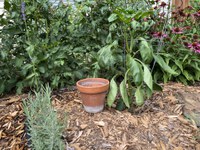Dakota Gardener: Olla watering
(Click an image below to view a high-resolution image that can be downloaded)
By Carrie Knutson, Horticulture agent
NDSU Extension – Grand Forks County
I will admit I scroll social media as much as the next person. However, my feeds are garden related. I saw a few posts about tips and tricks to keep vegetable gardens watered during dry conditions. One of those tips was using olla watering.
I had not heard of olla watering. So, I had to do some fact checking and research before I changed any of my gardening practices.
Olla watering is a very old form of irrigation using clay pots that are buried in the soil and filled with water. Unglazed clay pots are porous and will allow water to move into the surrounding soil. The superpowers of water and soil move the water through the soil profile.
Soil has spaces in between soil particles (sand, silt and clay) and soil aggregates (groupings of soil particles and organic matter). These pores can be very small or large depending on the soil characteristics. For example, based on soil texture, a sandy soil will have larger pores while a soil with more clay will have smaller pores.
Larger pores do not hold on to water very well and the water will drain after rain. This is usually referred to as gravitational water. The water that stays in the smaller pores is held more tightly and is referred to as field capacity water. Soil is said to be saturated when all the pores are filled with water. Soil pores are connected and help water move through the soil. Water will flow in soil pores from areas of higher concentration to areas of lower concentration.
Olla watering uses the movement of water in soil pores to distribute water in a garden. The soil pores closer to the olla will be saturated and water will move outwards to open soil pores. Olla watering can reduce water waste by preventing run-off and reducing evaporation, by placing the water in the soil right where it needs to be.
How big of a clay pot do you need in your garden to make a difference? In their publication “Irrigating with Ollas,” the University of Arizona Cooperative Extension estimates that water from an olla will move out twice the diameter of the pot. For example, a 10-inch clay pot will provide water to an estimated 20-inch area round the plant. Remember this can vary depending on environmental conditions and soil texture.
There are pots specifically designed to be used for olla watering. Unglazed clay pots also can be used for olla watering. The drain holes will need to be sealed so the pot holds water. Usually, the olla has a cover to prevent evaporation.
The downside to olla watering is the added expense of buying pots, as well as displacing soil and reducing growing space.
My garden space is limited, and I don’t really want to spend more money on clay pots. So, I will continue to use my soaker hose and water with a sprinkler in the morning. If olla watering sounds like it will help you, give it a try! Happy gardening!
NDSU Agriculture Communication – Aug. 8, 2023
Source: Carrie Knutson, 701-780-8229, carrie.knutson@ndsu.edu
Editor: Kelli Anderson, 701-231-6136, kelli.c.anderson@ndsu.edu




